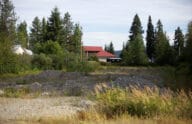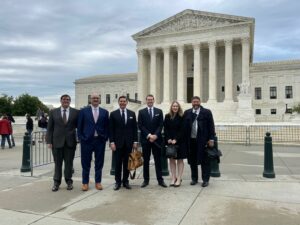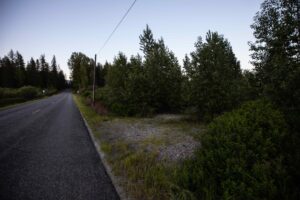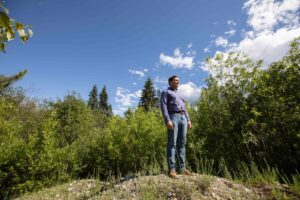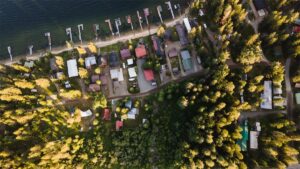Video: Damien Schiff Discusses Sackett v. EPA

On October 3, 2022, Sackett v. Environmental Protection Agency will be the first case argued in the new term at the Supreme Court. The case allows the Court to continue where West Virginia v. EPA left off—reining in the administrative state.
Damien Schiff, senior attorney at Pacific Legal Foundation, representing the Sacketts, visited the Sackett property and answered several questions about the case.
Video footage is available for media use in covering this case. Attribution should go to Pacific Legal Foundation.
Have a follow up question? Email .
Table of Contents:
What is at stake in Sackett v. EPA?
How does the Clean Water Act expand the power of the government over private property owners?
Who are Mike and Chantell Sackett and how did this case get started?
How did Pacific Legal Foundation get involved in Sackett v. EPA?
Where is the Sacketts’ property located?
The Sacketts won their case the first time at the Supreme Court in 2012. Why are they back?
What will be decided by the Supreme Court this time around?
What happens if the Sacketts win?
What precedent will be set if the Court rules for the Sacketts?
Would a win for the Sacketts make the law clearer?
What impact could this case have beyond the Sacketts and their property?
If the Sacketts lose, what would be the fallout?
Why should the Sacketts’ case matter to other Americans?
What is the most outrageous fact of the whole case?
Does the Sacketts’ property have any connection to a body of water?
Why did Congress originally pass the Clean Water Act?
What was the Clean Water Act intended to do?
How has the EPA changed the definition of “navigable waters” under the Clean Water Act?
How have the EPA’s mission and authority changed?
What are some consequences of the EPA’s expansion of power?
What other harms has the EPA’s enforcement of the Clean Water Act caused?
How far does the EPA’s overreach extend?
What is at stake in Sackett v. EPA?
|
Transcript: In Sackett v. Environmental Protection Agency, the question is whether Mike and Chantell Sackett need to obtain permission from the EPA to build their family home here in Priest Lake, Idaho. The dispute arises from a 2007 order the EPA issued telling the Sacketts that their homebuilding was violating the Clean Water Act because their property contained wetlands supposedly regulated under the Clean Water Act. Now, if you look at the Clean Water Act, it doesn’t say you need to get a permit from the federal government to build a home. What it does say is that if you’re going to discharge pollutants into the waters of the United States, then you need a permit. The EPA takes the position that this land we’re standing on right now, located within a residential subdivision in Priest Lake, Idaho, this land is considered a water of the United States and therefore requires a permit from the EPA. And because the Sacketts didn’t obtain such a permit before they began constructing their family home, they therefore–in the EPA’s view–violated the Clean Water Act. And that’s the dispute that’s been going on now for the past 15 years: Whether, in fact, the federal government, in particular the EPA, has the authority to tell the Sacketts that they can or cannot build their home. |
| Download Video | Download Audio |
How does the Clean Water Act expand the power of the government over private property owners?
|
Transcript: You have the law passed in 1972. It is designed to regulate the waters of the United States, but over the course of 50 years, the EPA and the Army Corps of Engineers have, by regulation, radically expanded the scope of the Act. And now, arguably, any wet area in the country is at least presumptively regulated by the EPA and the Army Corps. And that’s a radical expansion that has happened without any legislative change. It’s not as if Congress has said, “Go ahead and start regulating all these other activities, all these lands that might have some effect on water quality.” Rather, it’s been the agencies themselves who’ve effected this huge expansion of the Act. |
| Download Video | Download Audio |
Who are Mike and Chantell Sackett and how did this case get started?
|
Transcript: Mike and Chantell Sackett have lived here in Priest Lake for many years. They purchased this lot of land that we’re on now in 2004, with the goal of ultimately building their family home on the site. Now, of course, those plans have been put on indefinite hold, beginning in 2007 when they started to build, with all local building permits in hand, only to be told by the EPA that no, you can’t build here—you need a federal permit because there are wetlands on the property that are regulated under the Clean Water Act. |
| Download Video | Download Audio |
How did Pacific Legal Foundation get involved in Sackett v. EPA?
|
Transcript: The Sacketts came to Pacific Legal Foundation through the local attorney they hired initially to respond to the EPA’s order to stop home construction. The Sacketts, of course, had been blindsided by that order because none of their neighbors, nobody in the area, had ever heard about the need to obtain a federal wetlands permit, in order to build a home. |
| Download Video | Download Audio |
Where is the Sacketts’ property located?
|
Transcript: Priest Lake is one of the most beautiful lakes in Idaho. It’s about 26,000 acres, about 17 miles long, and a couple miles wide. It’s a very popular place for boaters, for swimming, for all sorts of recreational activity. Priest Lake is very popular as a vacation destination. Where we are right now is a little subdivision along the southwestern shore of the lake. The Sacketts’ property, which is two-thirds of an acre, is located here within an existing subdivision that has been largely built out. Were it not for the trees behind me, you could see a row of houses that separate this lot from the lake shore. |
| Download Video | Download Audio |
The Sacketts won their case the first time at the Supreme Court in 2012. Why are they back?
|
Transcript: The first time the Sacketts went to the Supreme Court, it was just to get through the Court’s doors. The lower courts had held that the Sacketts and other property owners who had been issued a compliance order by the EPA didn’t have the right to go into court immediately to challenge the EPA’s authority. So the Supreme Court held, the first time, that the Sacketts do have the right to sue immediately, that they don’t have to wait for something else to happen. |
| Download Video | Download Audio |
What will be decided by the Supreme Court this time around?
|
Transcript: The second case, which will be heard in October of 2022, now goes to the heart of the matter—that is, does the EPA in fact have authority under the Clean Water Act to stop the Sacketts’ homebuilding project until they obtain a permit from the Army Corps? |
| Download Video | Download Audio |
What happens if the Sacketts win?
|
Transcript: A win for the Sacketts now, this second time, would have a tremendous impact, not just for the Sacketts but for property owners throughout the country, because the case now gives the Supreme Court an opportunity to clarify what it tried to do back in 2006 in the Rapanos case—to establish a clear and appropriately defined rule for limiting and establishing EPA and Army Corps’ jurisdiction under the Clean Water Act. |
| Download Video | Download Audio |
What precedent will be set if the Court rules for the Sacketts?
|
Transcript: This case gives the Supreme Court the opportunity, not only to bring consistency to how the Clean Water Act is administered, but also to impose some real limits on the authority of the EPA and the Army Corp to regulate under that Act. |
| Download Video | Download Audio |
Would a win for the Sacketts make the law clearer?
|
Transcript: A win for the Sacketts at this point would result, potentially, in freeing up hundreds of millions of acres of wetlands in the country to be put to productive use. Right now, most wetlands are going to be regulated to some degree by the Clean Water Act, and that is a huge overexpansion of the statute that Congress never authorized, but which the EPA and the Corps, over the course of the past several decades, have achieved through the regulatory expansion of the Act. So if the Supreme Court can stop that regulatory expansion and reimpose the statutory limits that Congress originally imposed, there would be a significant opportunity for productive activity in areas that right now just can’t occur. |
| Download Video | Download Audio |
What impact could this case have beyond the Sacketts and their property?
|
Transcript: A win now for the Sacketts would free up hundreds of millions of acres of land that until now has really been locked up in this overexpansion of the Clean Water Act. What that means is productive activity can go forward—like homebuilding and farming. |
| Download Video | Download Audio |
If the Sacketts lose, what would be the fallout?
|
Transcript: A loss at the Supreme Court now essentially would ratify what the EPA and the Army Corps have been doing for the past several decades—that is, using the Clean Water Act to regulate all sorts of land use in the country: homebuilding, farming…you name it. |
| Download Video | Download Audio |
Why should the Sacketts’ case matter to other Americans?
|
Transcript: The Sacketts’ case should matter to all Americans for a number of reasons. For one, the Sacketts’ case concerns whether one has the right to reasonable use of one’s property, and I think that implicates anybody in the country who has land or is interested in protecting private property. But second, the case is important for everybody because it deals with agency overreach. We all know that the administrative state is involved in almost every aspect of existence nowadays. If the agencies here—the EPA and the Corps—are allowed to abuse their authority, then that would be a terrible example for agencies around the country. And that’s something everybody should care about. |
| Download Video | Download Audio |
What is the most outrageous fact of the whole case?
|
Transcript: The most outrageous fact of this case is that you have two-thirds of an acre that’s been zoned for the construction of single-family housing. It has a sewer hookup. It’s bordered by other parcels that have homes on them. Nevertheless, the EPA thinks that this lot contains waters of the United States. Not because there’s actually any body of water on the site, but because across the street, there’s a ditch that drains about 35 acres of wetlands. Those wetlands then drain into the ditch that goes into a creek that ultimately flows into Priest Lake. It’s because of that circuitous theory of jurisdiction that the EPA thinks it has authority to regulate this property. Even though there’s no surface water connection at all between this property and any other body of water. |
| Download Video | Download Audio |
Does the Sacketts’ property have any connection to a body of water?
|
Transcript: This land has no connection to any water. And so, that the EPA can say this is waters of the United States where we’re standing right now, really just is beyond imagination. |
| Download Video | Download Audio |
Why did Congress originally pass the Clean Water Act?
|
Transcript: The reason Congress enacted the Clean Water Act was that, prior to that point, the federal government didn’t really have a comprehensive system for water quality regulation. And, in fact, people oftentimes point to the 1969 fire that occurred on the Cuyahoga River in Ohio. Now that was the original design of the Clean Water Act. As we’ve seen over the past 50 years, it’s been changed by administrative interpretation from being just a law that’s supposed to care about not allowing pollutants to be dumped into things like Priest Lake. |
| Download Video | Download Audio |
What was the Clean Water Act intended to do?
|
Transcript: The Clean Water Act was intended to be a law concerning water quality. It was not intended to be a land use ordinance, and yet that’s precisely what it’s been turned into by the EPA over the past 50 years in its administrative expansion of the statute. |
| Download Video | Download Audio |
How has the EPA changed the definition of “navigable waters” under the Clean Water Act?
|
Transcript: The definition that Congress enacted in 1972 is the same definition we have today—that is, navigable waters are waters of the United States. What’s changed over the past half-century is how the EPA and the Army Corps have interpreted that phrase. Now they interpret it to mean, essentially, that any wetland in the country, any land that has any amount of moisture on it, is at least presumptively regulated under the Act now because of the EPA’s and the Corps’ expansion through regulation. |
| Download Video | Download Audio |
How have the EPA’s mission and authority changed?
|
Transcript: The biggest change that’s occurred to the EPA over the past 50 years because of this administrative expansion of the Clean Water Act is that the agency’s been turned into a land use administrator. Now, that’s something you don’t usually expect a federal agency to be involved in. That’s something that’s traditionally governed by state and local law. And yet, because the EPA has so radically expanded the scope of the Clean Water Act, it now effectively dictates zoning at the federal level. |
| Download Video | Download Audio |
What are some consequences of the EPA’s expansion of power?
|
Transcript: Beyond the Sacketts’ case, the harms that have been caused by the EPA’s overreading of the Clean Water Act are manifold. For one, you can look at the cost of housing. You can look at limitations on land use, whether it’s farming or industrial activity. You name it—all of those limitations that the EPA has imposed have a cost. |
| Download Video | Download Audio |
How does the EPA’s overreach affect Americans?
|
Transcript: The EPA’s overreaches cause a lot of harms to people, not just to the Sacketts. There are a number of examples throughout the country of people who have been even criminally prosecuted. |
| Download Video | Download Audio |
What other harms has the EPA’s enforcement of the Clean Water Act caused?
|
Transcript: The harms caused by the EPA’s egregious administration of the Clean Water Act extend well beyond the Sacketts’ case to property owners around the country who have been sued by the federal government for having used their land without first obtaining a Clean Water Act permit. Many of these cases have entailed criminal enforcements. Even when they haven’t been criminal, the civil penalties have been immense. An example is farmers being fined more than a million dollars because they plowed parts of their field that the EPA said were off-limits. |
| Download Video | Download Audio |
How far does the EPA’s overreach extend?
|
Transcript: Beyond the Sacketts’ case, the EPA’s overreach extends to all sorts of property owners, whether you’re a homebuilder or a farmer. And, in fact, over the course of the past several decades, many people have been even criminally prosecuted for filling in their property without an allegedly necessary Clean Water Act permit. And even if these haven’t always been criminal charges, just the civil penalties have been immense. There have been instances of farmers being fined over a million dollars just for the mistake of having plowed parts of their fields that the EPA says should be off the table. |
| Download Video | Download Audio |
How has this case affected Mike and Chantell personally?
|
Transcript: This case has had a devastating impact on the Sacketts, because here they purchased this land over 15 years ago with the express purpose of building their family home on it. And they’ve been forced to rent for all this time because they haven’t been able to complete what they’ve always dreamed of—a beautiful family home here near the shores of Priest Lake. |
| Download Video | Download Audio |
Drone footage of the Sackett property and Priest Lake
|
Shots:1. Drone footage of Priest Lake and surrounding areas from off shore of the Sackett’s property. 2. Approaching and flying over the Sackett’s property from Priest lake. 3. Close up of the Sackett’s property zooming out. 4. View of Priest Lake rising up from the Sackett’s property. |
| Download Video |



